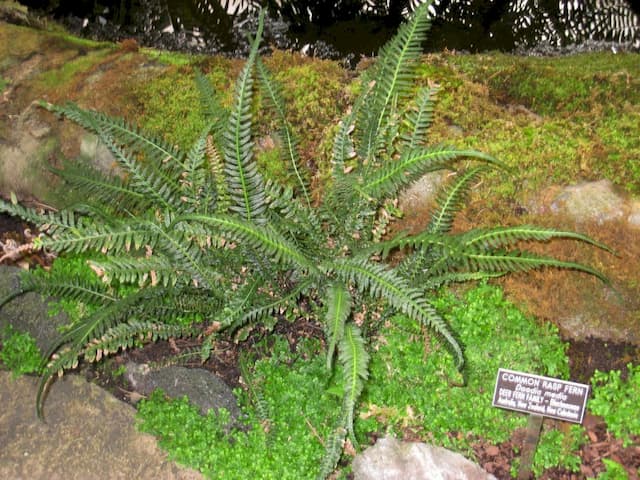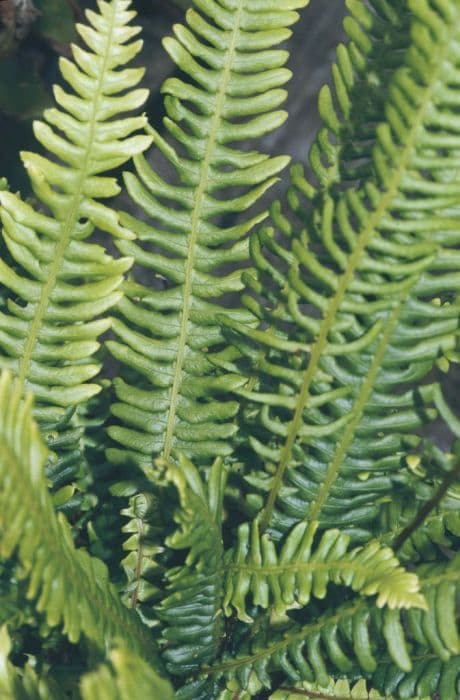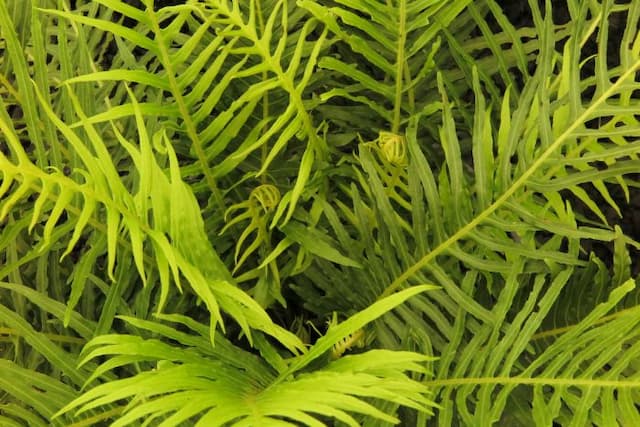Oriental Chain Fern Woodwardia orientalis

ABOUT
The plant known as Oriental chain fern features a lush, green appearance with long, arching fronds, creating an attractive, feathery display. The fronds of this fern are divided into numerous leaflets, each leaflet being further segmented into smaller sub-units, giving the foliage a delicate and finely textured look. The leaflets are arranged in a somewhat alternating pattern along the central stem, known as a rachis, contributing to the plant's overall graceful aesthetic. During the reproductive phase, the underside of the fronds will exhibit brown, spore-bearing structures, which are known as sori. These sori are arranged in linear patterns and add a subtle contrast to the green color of the fronds. The Oriental chain fern boasts a luxurious and verdant quality, fitting well in gardens or natural settings where its intricate and elegant foliage can be fully appreciated.
About this plant
 Names
NamesFamily
Blechnaceae
Synonyms
Oriental Chain Fern, Oriental Woodwardia
Common names
Anchistea virginica var. orientalis, Lorinseria areolata, Woodwardia areolata.
 Toxicity
ToxicityTo humans
Woodwardia orientalis, commonly known as oriental chain fern, does not have notable toxicity to humans. There are no well-documented cases or reports of poisoning from ingestion of this plant. Therefore, no specific symptoms of poisoning are associated with the oriental chain fern when it comes to human ingestion. However, as with any non-food plants, caution should be exercised, and it is generally not advisable to ingest parts of ornamental plants of unknown edibility.
To pets
The oriental chain fern, Woodwardia orientalis, is not commonly listed as a toxic plant to pets such as dogs and cats. There are no widely recognized symptoms of poisoning from this plant for pets. Although ingestion of non-food plants can sometimes cause mild stomach upset or irritation in animals, the oriental chain fern is not specifically known to be poisonous to pets. Owners should still prevent pets from ingesting plants that are not part of their intended diet to avoid any potential issues.
 Characteristics
CharacteristicsLife cycle
Perennials
Foliage type
Evergreen
Color of leaves
Green
Height
2-3 feet (0.6-0.9 meters)
Spread
2-3 feet (0.6-0.9 meters)
Plant type
Fern
Hardiness zones
6
Native area
Asia
Benefits
 General Benefits
General Benefits- Ornamental Value: Woodwardia orientalis, also known as Oriental Chain Fern, is prized for its aesthetic appeal in gardens and landscapes, thanks to its lush, arching fronds and vibrant green color.
- Shade Tolerant: This fern thrives in shaded areas, making it an excellent choice for underplanting in wooded gardens or areas with dappled sunlight.
- Soil Erosion Control: The root system of the Oriental Chain Fern helps in stabilizing soil, making it useful for erosion control in sloped or disturbed areas.
- Wildlife Habitat: The dense fronds provide cover and nesting opportunities for various small animals and insects.
- Low Maintenance: Once established in a suitable environment, this fern requires minimal care, making it a hassle-free addition to the garden.
- Moisture Indicator: Woodwardia orientalis typically indicates a moist, well-drained soil environment, hence it can be used as a natural indicator of soil moisture levels.
- Companion Planting: This fern plays well with other shade-loving plants, making it a good choice for layering and creating textured plantings in garden designs.
 Medical Properties
Medical Properties- This plant is not used for medical purposes.
 Air-purifying Qualities
Air-purifying QualitiesThis plant is not specifically known for air purifying qualities.
 Other Uses
Other Uses- Chain fern spores can be used as a flash powder in photography due to their flammable nature.
- The fibrous roots of chain fern are sometimes crafted into small pieces of fabric or paper in traditional handcrafts.
- The large fronds of the fern may serve as natural coverings or wraps for delicate fruits during transport.
- In landscaping, chain fern is often used as a natural fencing or border due to its dense foliage.
- Chain fern can also play a role in natural water filtration by being planted along the banks of water bodies to prevent soil erosion.
- The fern can be used as an indicator species in environmental studies for monitoring the health of ecosystems due to its sensitivity to pollution.
- Chain ferns can be incorporated into outdoor educational programs to demonstrate plant structure and growth in a fern lifecycle study.
- Dried fronds could be used in artistic endeavors, such as part of a natural material collage.
- Some cultures may use the fronds of chain ferns during certain rituals or as decorations during festivals.
- The plant can be used to add greenery to terrariums or other closed environments, not for air purification, but for aesthetic purposes.
Interesting Facts
 Feng Shui
Feng ShuiThe Oriental Chain Fern is not used in Feng Shui practice.
 Zodiac Sign Compitability
Zodiac Sign CompitabilityThe Oriental Chain Fern is not used in astrology practice.
 Plant Symbolism
Plant Symbolism- Resilience: Woodwardia orientalis, also known as Oriental chain fern, thrives in damp and shady environments, symbolizing the ability to grow and persist regardless of challenging conditions.
- Adaptability: This fern's capacity to adapt to different environments, ranging from rock crevices to woodlands, represents flexibility and the ability to thrive in various circumstances.
- Eternal Youth: Ferns often symbolize youth and new beginnings due to their green, lush appearance throughout the year, suggesting a sense of renewal and eternal freshness.
- Ancestry and Heritage: As ferns are ancient plants with a long evolutionary history, they can represent a connection to the past, our ancestors, and the wisdom of antiquity.
 Water
WaterThe Oriental Chain Fern should be watered deeply, ensuring the soil is consistently moist but not waterlogged. Water the plant with approximately 16 to 24 ounces of water, depending on the size of the pot and the environmental conditions, roughly once a week. Adjust the frequency during hotter, drier periods, possibly increasing to twice a week, and reduce watering in the cooler months to prevent waterlogging. It's crucial to provide enough water to soak the soil to the root level without leaving standing water, which can lead to root rot.
 Light
LightOriental Chain Fern thrives in partial to full shade, avoiding direct sunlight which can scorch its leaves. The ideal spot for this fern is in a location where it receives filtered or dappled light. It can also adapt to low-light conditions, making it suitable for indoor environments with limited natural light.
 Temperature
TemperatureOriental Chain Fern prefers temperatures between 60 to 75 degrees Fahrenheit and can tolerate a minimum temperature of 50 degrees Fahrenheit. Avoid exposing the plant to temperatures below 50 degrees Fahrenheit, as it could be damaging. The plant should be protected from extreme cold and kept in an environment with stable temperature conditions to thrive.
 Pruning
PruningPruning Oriental Chain Fern is primarily for aesthetic purposes, to remove dead or yellowing fronds and encourage fresh growth. Light pruning can be done at any time of year, but major pruning should be done in spring before new growth begins. Cut off the old fronds close to the base, and ensure tools are clean to prevent disease transmission.
 Cleaning
CleaningAs needed
 Soil
SoilOriental chain fern thrives in organic-rich, well-drained soil with a slightly acidic to neutral pH of 6.0 to 7.0. A mix of peat, pine bark, and coarse sand or perlite can provide the ideal texture and nutrients.
 Repotting
RepottingOriental chain ferns should be repotted every 2-3 years to refresh the soil and accommodate growth.
 Humidity & Misting
Humidity & MistingOriental chain fern prefers high humidity, ideally around 60-80%, mimicking its natural rainforest habitat.
 Suitable locations
Suitable locationsIndoor
Place in a humid spot with indirect light and ensure moist soil.
Outdoor
Plant in shaded area with moist, rich soil and protect from strong winds.
Hardiness zone
8-10 USDA
 Life cycle
Life cycleWoodwardia orientalis, commonly known as Oriental chain fern, begins its life cycle as a spore that germinates in a suitable damp environment to develop into a heart-shaped gametophyte known as a prothallus. The prothallus houses both male and female reproductive organs, which when mature, allow for fertilization, leading to the development of a zygote. The zygote then grows into a young sporophyte, emerging initially as a small fern before it develops its characteristic large, pinnate fronds. As the Oriental chain fern matures, these fronds bear sori on their undersides, which are clusters of sporangia where spores are produced. When the spores are ripe, they are released into the environment to disperse, and if they land in suitable conditions, they will germinate, thus completing the life cycle of the fern. The plant grows best in shaded, moist woodland environments and can reproduce and spread effectively in these conditions.
 Propogation
PropogationPropogation time
Spring-summer
The most popular method of propagating the Oriental chain fern (Woodwardia orientalis) is through spore sowing. This process involves collecting spores from the underside of mature fronds when they are ripe, usually in late summer. The spores should be sowed on the surface of a moist, sterile potting mix, such as a blend of equal parts peat and perlite. After sowing, the container should be covered with plastic wrap or placed within a plastic bag to maintain high humidity. It should be situated in a warm (around 70°F or 21°C), indirectly lit area. Germination can be slow and may take several weeks to months. Once the sporelings are large enough to handle, they can be gently transplanted into individual pots.




